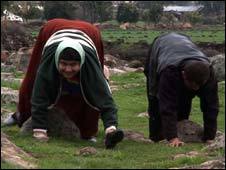Two of four Turkish families with members who walk on their hands and feet share a variant of the VLDLR gene, say Bilkent University researchers.
Presenting their work at a European genetics conference, they said it could reveal clues about human evolution.
But other experts said the idea of an "all fours gene" was "far-fetched".

|
| ©Passionate Productions |
| The families do not walk on two feet |
The shift from quadrupedal to bipedal walking is seen as one of the key developments in human evolution, and publicity about the families and their shared traits excited great interest in 2006.
They can be found in a rural area of Turkey, and several members of the families have spent their entire lives walking on both hands and feet.
The condition was also linked to speech problems and mental retardation, and was labelled "Uner Tan Syndrome" after the scientist who first wrote about it.
A colleague of Dr Tan presented his research into the genetic makeup of the families at the European Society of Human Genetics conference in Barcelona, finding mutations in the gene in two out of the four families.
Balance problems
The gene involved is VLDLR, which is known to be involved in the development of a part of the brain called the cerebellum.
The researchers said they were surprised to find that the same mutation was not present in the other two families, despite the presence of almost exactly the same condition.
Professor Tayfun Ozcelik, who led the research, said: "Whereas normal infants make the transition to walking on two legs in a relatively short period, these individuals continued to move on their palms and feet and never walked upright.
"Although they can stand from a sitting position and maintain this upright position with flexed hips and knees, they virtually never initiate bipedal walking on their own."
However, Professor Nicholas Humphrey from the London School of Economics, who has also examined the families, said that while genetic defects might well be responsible for the symptoms, it was not by influencing directly the shift from quadrupedality to bipedality.
"We know that other people with defects in this gene often have problems in the development of a part of the brain which means that they have trouble with their sense of balance.
"These family members basically started off crawling on all fours, for this reason, and stayed that way.
"I do not believe for a moment that what we have here is a gene for walking on all four legs."
He said that other people with VLDLR defects in the US had been successfully taught to walk upright, and that the principal difference was that the Turkish families had been "tolerant" of their children walking on all fours.
Following his own study of the families, he said, one of them had been given a zimmer frame for the first time, and immediately had begun walking upright using it.
However, this was rejected by Professor Ozcelik, who insisted that some of the families had made strenuous efforts to correct their children's gait.
"The parents in family A also discouraged their affected children from walking on all fours, to no avail.
"We think that social factors are unlikely to be involved in the development of quadrupedal locomotion."



Reader Comments
to our Newsletter